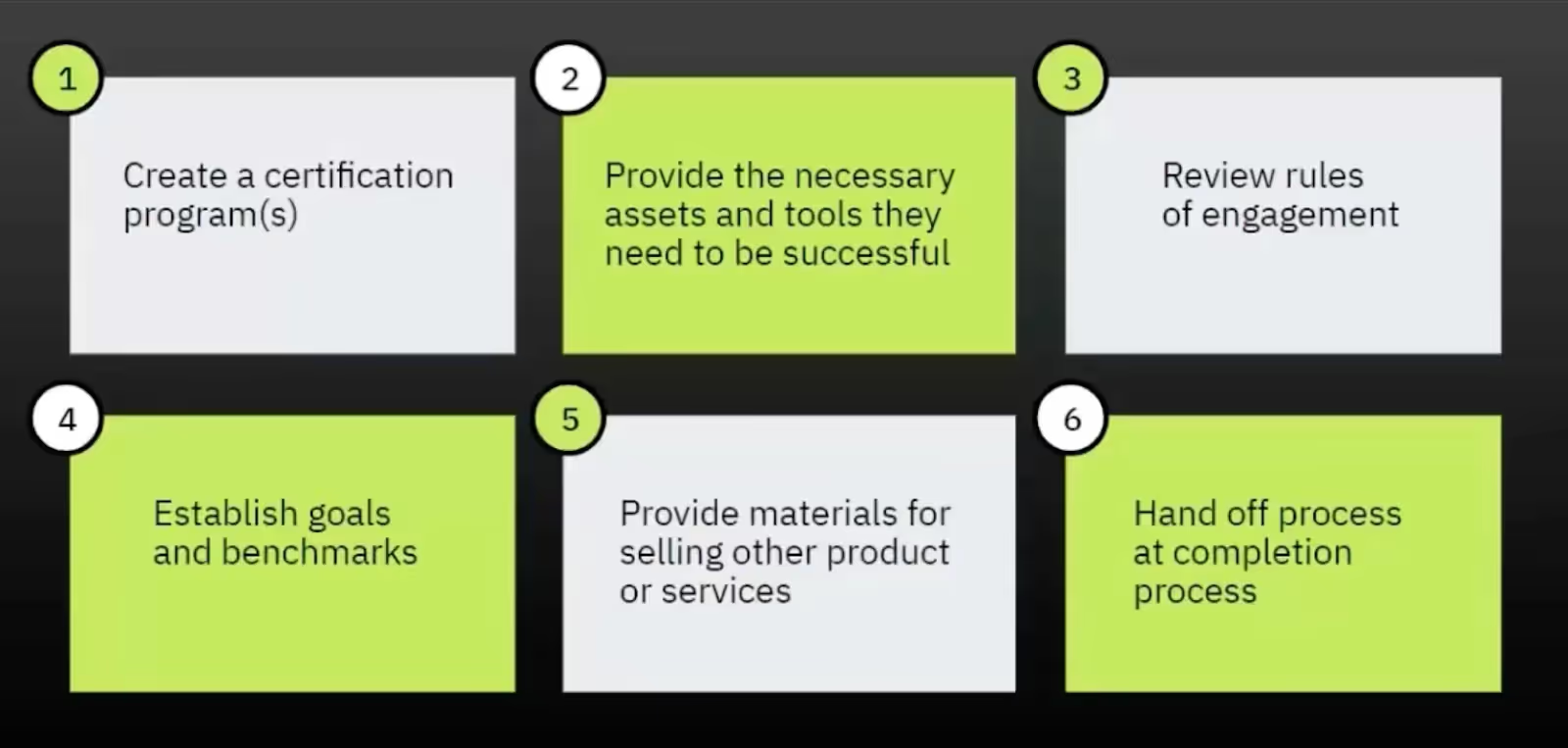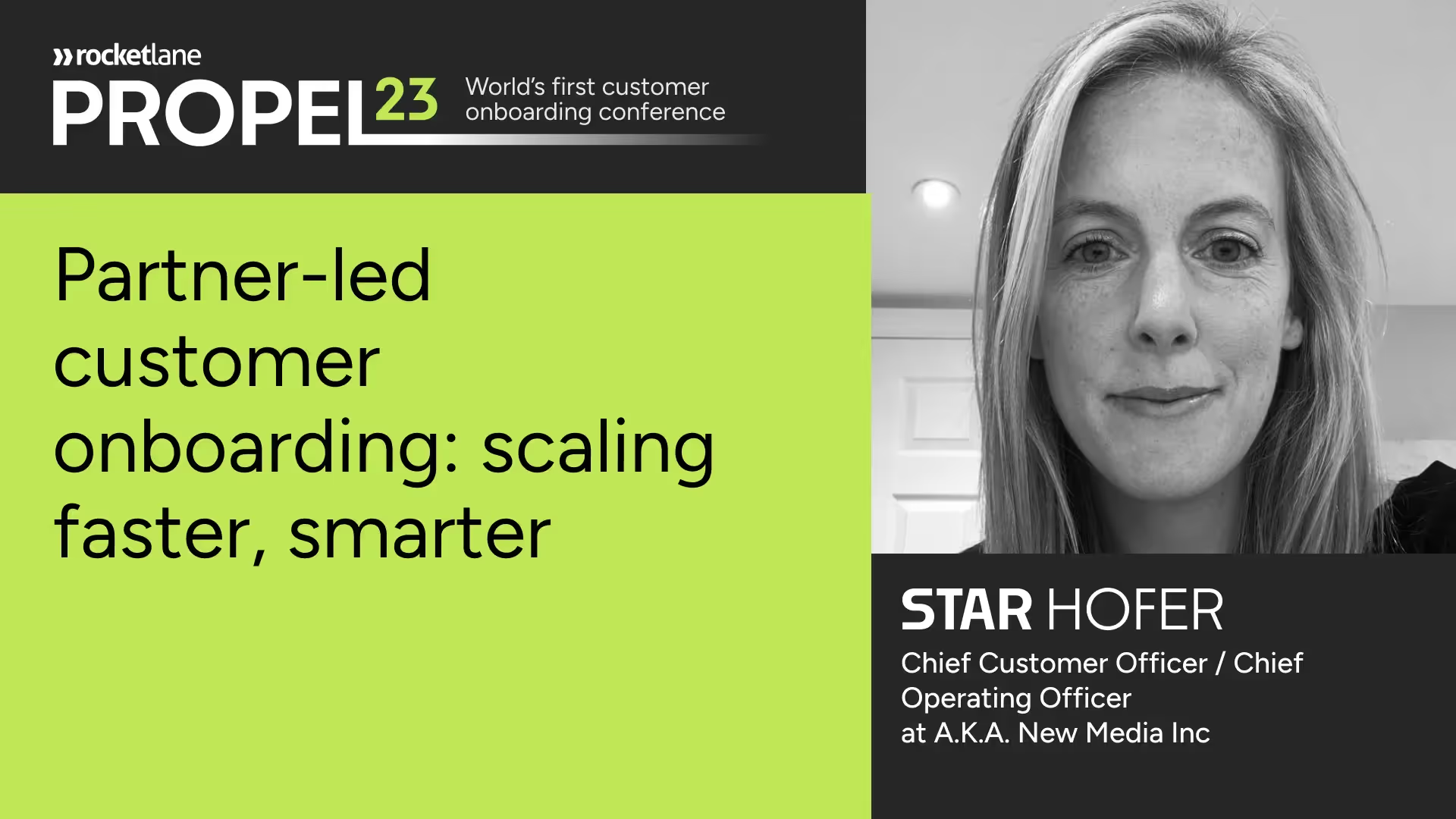More resources
- Tune into our Propel recordings from the world’s only global conference for customer onboarding
- Gain valuable insights from the most successful Implementation Stories in the industry.
- Engage in thought-provoking discussions within our community by checking out Preflight Conversations.
- Discover The Launch Station podcast, your go-to source for everything customer onboarding.
- For more valuable customer onboarding materials, check out the resources from Rocketlane here.
At Propel23, the Chief customer officer at A.K.A. New Media Inc. and one of the Top 50 Women Leaders in Customer Success 2022, Star Hofer, discussed partner-led customer onboarding. She highlighted the numerous advantages of such an approach and valuable insights and recommendations based on her experience.
In this session, Star spoke about:
- Reasons to start using parter-led customer onboarding
- Where and how to begin the journey to partner-led customer onboarding
- Onboarding and activation of partners
- How you can nurture partners for a successful customer experience.
Here are the major takeaways and key points from the session.
Why leveraging partners for customer onboarding makes business sense
1. Faster onboarding
Using partners with expertise in onboarding can greatly improve the speed of the process. Partners can offer valuable consultations, bridging gaps in expertise, especially during periods of high volume or without specific skills. By harnessing these partnerships, you can streamline and optimize the onboarding process, ultimately saving valuable time and resources for your organization.
2. Improving customer experience
Customers may require additional services beyond what your organization can offer as part of the standard onboarding experience. By collaborating with a partner, your organization can offer a more comprehensive onboarding experience that meets the unique needs of these customers.
3. Deeper insights
Since the partner might already have an established working relationship with the customer, they possess valuable knowledge about navigating that specific organization. This familiarity enables them to understand and anticipate organizational behaviors and decision-making processes you might not know. By relying on their expertise, you can ensure a more efficient and effective onboarding experience for the customer.
4. Increased revenue
If the partner organization has a positive experience with your product and recognizes its value for their customers, they will likely be motivated to pursue avenues for growth. This could involve expanding their customer base, upselling or cross-selling your product, or exploring new markets.
Four key benefits of partner-led customer onboarding
1. Volume and scale
Partnering with external service providers can address the challenges of high volume and scale in your organization. By leveraging experienced individuals from service partners, you as a business can augment your workload during surges or seasonal fluctuations without hiring and training additional staff. This allows for more efficient management of resources and ensures optimal service delivery during peak demand periods. Whether handling an influx of work or managing seasonality, partnering with service providers provides a flexible and cost-effective solution for addressing volume and scale challenges, enabling you to meet customer demands effectively.
2. Expertise
Expertise is a great way of augmenting your offering or bringing in more partners, especially if you have a complicated product or your product might be new. Educating customers and taking them on a journey requires specialized expertise, which can be challenging to develop internally. By leveraging partners' expertise, you can ensure a smooth customer experience and enhance your market positioning.
3. Geographical reach
Expanding into new regions becomes easier when you partner with individuals or organizations with an established presence. Local representation eliminates the challenges of managing time zone differences and enables immediate access to the target market. Additionally, collaborating with culturally sensitive partners who deeply understand the local markets can greatly enhance business operations and successful expansion into new regions.
4. Strategic goals
If your company already has a well-established program, consider leveraging partners to maintain existing operations while focusing your internal team on exploring new verticals or markets. By offloading the maintenance responsibilities to trusted partners, you can allocate more resources to building and refining the customer journey for the new space you are venturing into. This approach balances the balance between maintaining success and actively pursuing growth opportunities.
Implementing a partner-led approach
The first step is to identify your ideal partner persona. Understanding the specific focus and problem you want to solve is crucial.
Do you need a partner that can handle high volume and scale? Or one with expertise in a particular area?
You may require a partner in a specific geographical region. Understanding your ideal customer or partner persona is crucial for attracting the right partners and ensuring successful collaborations. Invest the time to document your requirements and identify the ideal partner persona. Once you have identified your ideal partner persona, you can move on to building a successful partnership.
When building partnerships, here are a few sources that can help you find the right partner:
1. Agencies or consulting firms in your area of expertise
These partners often have various names, such as solution or implementation partners. Depending on your specific needs, you can explore four different areas, including consulting firms or agencies that specialize in your required expertise. These firms can help bridge any knowledge or skills gaps and bring valuable expertise to your partnership.
2. Employees/ customers looking to start their own business
If you seek partners who can handle high volume or scale, individuals with an entrepreneurial spirit and a desire for flexibility can be excellent partners. These individuals, who may be employees or customers looking to transition into entrepreneurship, can provide support during peak periods and help navigate fluctuations in demand.
3. Your competitors’ partners
Exploring your competition and identifying the partners they are working with can be a valuable strategy. Partners often work with multiple products, including competing ones. By collaborating with partners who already have established relationships with your competition, you can leverage their expertise and potentially gain more visibility and opportunities. Building strong relationships with these partners can help elevate and promote your product, particularly if they have a positive experience working with you.
4. Inbound referrals
The final, although slightly challenging, approach is to attract inbound referrals from potential partners. To facilitate this, create a dedicated webpage targeting solution recommendation partners on your website. Explain your partner program, promote it, and encourage interested parties to apply. This process can mirror your existing sales program, providing a structured onboarding process for new partners.
Star recommends narrowing your focus and choosing one area to explore for partner recruitment.
For instance, agencies, consulting firms, or niche specialists can be valuable partners if you require expertise.
If you need volume, consider leveraging the knowledge and experience of past customers or employees familiar with your products.
The number of partners needed depends on whether your business strategy is volume-focused or expertise-driven.
Onboarding and activation of partners
Once you have identified the ideal partner persona, the next critical step is to onboard the partners effectively. To maximize the effectiveness of these partnerships, it's crucial to view partners as an extension of our team. While they may not be direct employees, treating them as such and investing in a comprehensive onboarding program is essential. This partner onboarding process should include thorough training, resource access, documentation, and ongoing support to ensure smooth integration and mutual success. Here is a six-step approach to guide you:

Create a certification program(s)
The initial step is to establish a certification program. This is to ensure that partners possess the same level of product knowledge as an employee on your onboarding or implementation team.
Provide the assets and tools they need to be successful
After implementing a certification program, the next crucial step is to equip partners with the necessary assets and tools to thrive, similar to how you would support your employees.
Review the rules of engagement
Establishing guidelines for partner interactions is vital to ensure clear and well-defined rules of engagement. These guidelines outline how partners should engage with you, your customers, and potentially your Customer Success Manager (CSM) or sales team. By having a tight set of rules, you can prevent any misunderstandings or misaligned expectations. This will help avoid bias and ensure everyone understands how to engage and collaborate properly.
Establish goals and benchmarks
To ensure partners clearly understand what they are working towards, it is important to establish goals and benchmarks, similar to how you would with employees. This involves defining the desired outcomes and objectives of the partnership and setting measurable performance benchmarks.
Provide materials for other products or services
To support your partners in selling other products and services, providing them with the necessary materials and information is crucial. This includes informing them about any changes or advancements in your product offerings. You ensure that your partners are equipped with the latest knowledge by sharing updates on upcoming developments, new features, or future releases.
Set up a well-defined handoff process between partners and your team
Effective engagement requires a seamless handoff process between different teams or partners. This includes transitioning from sales to service or partners back to Customer Success Managers (CSMs). The handoff process is critical in ensuring a smooth and efficient customer journey. In addition, you also need to identify and resolve any challenges or potential issues that may arise during the handoff process.
Nurturing partner relationships
After bringing a partner on board, nurturing the relationship is crucial for long-term success. Here are the steps to effectively nurture a partner:
Assign a channel manager
Assign a designated person, such as a channel manager or partnership manager, who will serve as the primary correspondent with the partner. This person will be responsible for building and maintaining a strong relationship with the partner, similar to how a customer success manager (CSM) works with customers.
Establish an engagement plan
Use the gathered insights to develop a tailored engagement plan for each partner. The plan should outline communication frequency, preferred channels of communication, and specific activities or touchpoints that will support their success. Be flexible with the engagement plan, understanding that different partners may have varying needs and preferences.
Design a compensation model for partners
Determining how to compensate partners for onboarding services depends on your business model. For complex implementations with existing fees, partners can pass the entire fee, a partial amount, or integrate it into their pricing.
You can also look at compensating partners based on the volume of onboarding. For expert partners, such as consulting firms that offer their own scoping and additional services, you could look at bulk pricing or a kickback arrangement.
The compensation model also needs to consider if partners refer customers or solely provide onboarding services. It is crucial to align the model with the partner's persona, target market, volume, expertise, geography, or new market focus.
Measure success of the partnership
To measure a partner's success, tracking various metrics and indicators over time is important. Here are some key metrics to consider:
1. Time-to-value: Assess how quickly the partner can generate value for their customers. Look at the onboarding process, implementation timelines, and the partner's ability to deliver results promptly.
2. Retention rate: Measure the longevity of partnerships by evaluating the retention rate of the partners and the customers they work with. A high retention rate indicates successful partnerships and satisfied customers.
3. Expansion rate: Monitor how often partners can expand their relationships with existing customers. A high expansion rate indicates that the partner is successfully growing their business and fostering strong relationships.
4. Customer satisfaction: Gather feedback from customers to assess their satisfaction with the partnership and the services provided by the partner. Regularly measure and track customer satisfaction scores or use customer surveys to monitor and improve the partner's performance.
5. Adoption rate: Evaluate how quickly customers adopt and implement the partner's solutions or services. Measure the adoption rate and assess any challenges or barriers that may affect adoption. A higher adoption rate indicates a successful partnership and the partner's effectiveness in driving customer engagement.
Regularly review these metrics and measurements to track the partner's success. Open communication and sharing these insights with partners will foster collaboration, strengthen the relationship, and help showcase the mutual benefits gained from the partnership.















